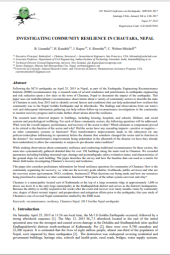Investigating Community Resilience in Chautara, Nepal
Summary
This paper details a multidisciplinary reconnaissance study conducted by the Earthquake Engineering Reconnaissance Institute (EERI) in the town of Chautara, Nepal, following the M7.8 earthquake in April 2015. The research team, consisting of academics and practitioners in earthquake engineering, assessed the impacts on buildings, lifelines, and social systems in Chautara. They explored recovery progress and resilience factors, examining the performance of various sectors and identifying critical elements. The paper also presents detailed data on over 150 buildings, outlining structural types, damage assessments, and ground slope characteristics. Additionally, the study addresses broader questions about community resilience, recovery organization, decision-making processes, and urban system survival in Chautara. The findings aim to inform future investigations and contribute to understanding community resilience in the aftermath of seismic events.
Categories:
Conference Paper
Publisher:
16WCEE
Published Year:
2017
